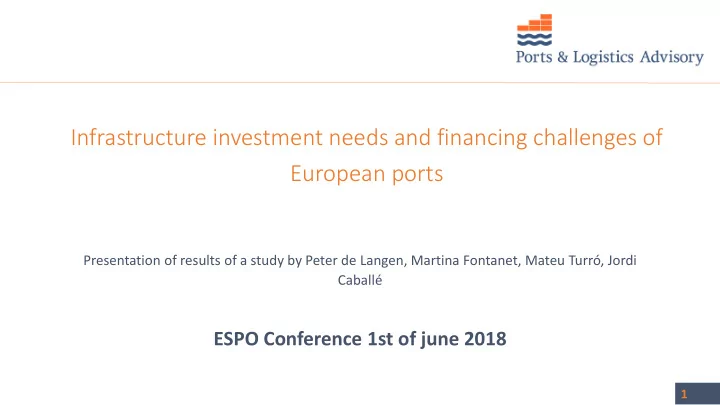

Infrastructure investment needs and financing challenges of European ports Presentation of results of a study by Peter de Langen, Martina Fontanet, Mateu Turró, Jordi Caballé ESPO Conference 1st of june 2018 1
The investment needs of EU ports are around €5 billion per year Source: Port Investment Survey, with replies from around 50% of the EU core ports and around 10% of all comprehensive ports, with data on almost 400 investment projects. The responding seaports cover over 61% of the total cargo throughput in the EU 27. Two additional conclusions 1. Investments in basic port infrastructure continue to be the main investment category. 2. Broad variety of types of port infrastructure, including for instance energy-infrastructure. 2
Investment needs of EU ports are driven by external developments Frequency of relevance of various drivers for all investment projects • Basic port infrastructure Expected growth of trade flows investments are chiefly Increasing size of vessels driven by expected Pollution mitigation growth of trade Decarbonisation of economy and associated energy volumes. transition • Maritime access Societal pressure and policies for a modal shift investments are driven Increasing pressure to the use of port land for urban functions by both scale increases Expected growth of cruise passenger volumes and expected trade increases Expected growth of ferry passenger volumes Increased digitalisation of transport chains 0% 10% 20% 30% 40% 50% 60% 70% 80% 3
Investments in port infrastructure create economic value as well as societal value • The vast majority of all projects creates value for Value creation mechanisms of the projects future users Value for future users • 80% of projects creates value for current users Value for current users • 50% of projects reduces Value for society, through reduced the environmental environmental footprint footprint Value for residents in surroundings, through reduced negative effects • Smaller fractions of Value for citizens, through enabling the projects create value for transfer of port land to urban functions nearby residents or for 0% 20% 40% 60% 80% 100% residents of port cities 4
The societal value creation calls for public funding Hurdle rate for public funding • Business case for the Positive port managing body may 2 1 Case for not Case for be negative, while the granting investment, ‘value case’ for society is permits (not no public common in funding positive. ports) need. Financial Hurdle rate for • For such types of business 3 4 port managing investments (type 2 case for the body port Case for No case to projects in the figure managing public make below), port managing body funding investment bodies are faced with a Negative funding gap. Positive Negative Societal value case 5
The funding challenge: bridging the funding gap • The best method to bridge the funding gap is an EU wide competitive funding mechanism for port managing bodies, as this prevents major distortions of the playing field and places investment initiative as well as a healthy part of the risks with the port managing body. • The case for public funding of port infrastructure is the development of EU funding and financing instruments (CEF, EFSI, EIB). • Between 2014 and 2017, ports have requested 2,5 €billion, and were granted 860 €million (35%) The 860 €million represents 4% of the EU funding between 2014 and 2017. • The development of port managing bodies towards autonomous, commercially operating and self-financing organisations, enables a greater use of blended financing instruments. This reduces the risks associated with providing grants alone, such as overly optimistic demand & impact forecasts. • Nevertheless, grants remain a key element in securing that investments that create value for society can be made. 6
Towards better grant allocation mechanisms • A substantial part of the societal value creation of port infrastructure investments is relevant at the EU level. This includes effects of investments on EU regional convergence, positive environmental effects (incl CO2 reduction) commitments, increased energy independence, effects at the European scale (incl. EU CO2 commitments) and improved international EU relations (e.g. the Neighbourhood Policy). • The European value creation is not dependent on or related to ‘cross border’ infrastructure. While ‘cross border’ criteria are relevant for the links in the EU network, that applies much less to the nodes , such as ports. • More in general, more clarity on the approach and methods of measuring EU added value is a step forward. • Finally, ports would benefit from a more balanced distribution of available resources over time, transparency regarding the final selection of projects by the committee of DG MOVE and INEA and more flexibility to modify proposals after funding has been granted. 7
Recommend
More recommend